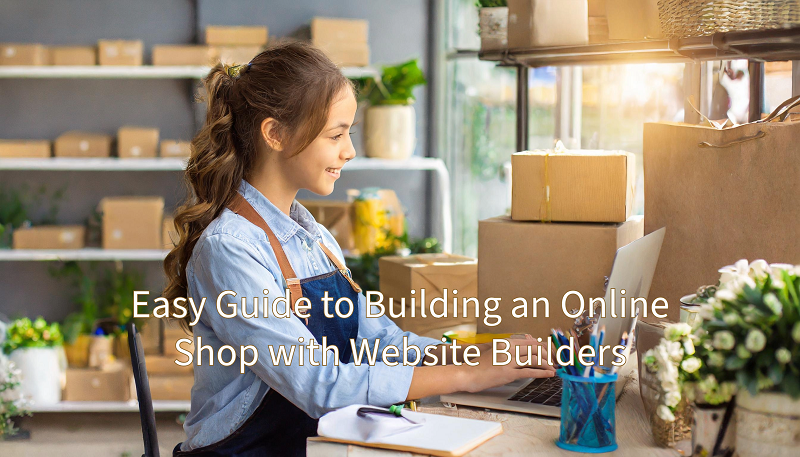Due to availability of many website builder tools, creating an online shop is a piece of cake. Whether you are just starting out in business or already have a well-established company, making an e-commerce website is normally a simple job that can be done with little hassle. This guide will take you through the entire process of launching your own online shop using a website builder, including how to choose the right platform and even run it.
1. Choose the Right Website Builder
The initial step towards creating an online shop is by selecting the best website builder for your needs. Some of these include Wix, Shopify, BigCommerce and Squarespace. These sites offer different features and therefore one should consider some factors such as:
- Shopify: Best for those looking to focus solely on e-commerce with strong features and integrations.
- Wix: Best for small businesses and beginners offering flexibility and ease of use.
- Squarespace: For people who need beautiful design focused templates.
- Big Commerce: Designed for larger organizations requiring advanced e-commerce functionalities.
2. Sign Up and Select a Plan
Once the choice has been made, sign up on your preferred site building tool .Most providers offer different pricing plans including free trial periods especially during their initial phase in the market. Think about what you would like to spend each month as well as which extra functions are necessary. The higher level plans come along with additional features like:
- More storage space and bandwidth
- Additional email accounts
- Advanced marketing tools
3. Pick a Website Name
Your domain name is the online address of your store and therefore it should be memorable and apt for your brand name. Most website builders include domain registration as part of their service. Some helpful tips to help you when choosing a domain:
- Shorten it and make sure it’s easy to spell
- Try not to use numbers or hyphens
- Use relevant keywords for your industry
4. Choose a Theme
Website builders have different templates that are specifically designed for e-commerce sites. Selecting one that matches with your brand and product offering is necessary. Many platforms allow you to modify these templates according to your branding including color, font, layout etc. Main considerations in choosing a theme are:
- Less cluttered, more professional look
- Mobile-friendly (which will give an idea about mobile responsiveness)
- Easy usability.
5. Personalize Your Storefront
Customization of the storefront involves tailoring the template towards reflecting your brand identity. This includes;
- Logo and Branding: Upload logo as well as choose colors, fonts that coincide with the overall design of the site.
- Homepage Design: Create an appealing homepage featuring high-quality images, promotional banners and call-to-actions which are succinct.
- Navigation: Set up a simple navigation bar that can easily guide customers to various products on offer in just a few clicks away.
Read also: Social Commerce 2024: Social Media and Shopping
6. Include Your Products
Adding products to your online store is very important. Please include the following on each product listing:
- Quality Images: Post a number of pictures that show various aspects and angles of the item.
- Product Descriptions: Write clear, concise descriptions that focus on main features and benefits.
- Pricing and Inventory: Set your prices and stock levels. Website builders have tools for inventory tracking; they also send you notifications when stocks are low or out.
7. Configure Payment Gateways
To start selling products online, you will need to install payment methods. Most website builders can be easily integrated with PayPal, Stripe or Square which are popular payment gateways. The choice should be made depending on what payment options best fit your business and clients. Consider accepting different types of payments for ease of shopping:
- Cards (Credit/Debit): Customers can pay with their cards at the checkout.
- Wallets (Digital): You may accept payments via PayPal, Apple Pay, Google Wallet etc.
- Payments offline: Accept cash-on delivery orders or bank transfers as well as other similar methods
- What Are The Best Ways to Earn Money Online as a Student?

- How Can We Earn From Quora?

- Ways to Make Money Online Fast in 2024

- How To Make Money on YouTube

- What is the full procedure for YouTube Earning?

- How can I earn money from Google Maps as a review provider?

8. Customize Shipping Rates
Another essential step here is customizing shipping rates. Typically website builders offer a range of shipping settings including:
- Flat Rate Shipping: Charge one fixed price for delivery irrespective of how much buyers have bought from you.
- Free Shipping: Offer free deliveries to attract customers based on total purchase amount or geographic areas where they live in.
- Real-Time Shipping Rates: Integrating with carriers to provide accurate shipping costs based on weight, dimensions, and destination.
9. Add Vital Pages
To provide information and foster trust with customers, there are some key pages that should be included in your online shop:
- About Us: Share your brand’s story, mission and values.
- Contact US: You need to include an email address, phone number and contact form where the customers will be able to reach you.
- FAQ: Frequently Asked Questions about your products, shipping and return policies.
- Privacy Policy and Terms of service: This is a legal information which will protect you from any inconveniences from the government agencies while at the same time informing your customers about their rights.
10. Set Up SEO
Search engine optimization (SEO) is vital when it comes organic traffic for your online shop. Website builders offer SEO tools to help you optimize your site:
- Keyword Research: Find keywords that are relevant for your products so as to include them in descriptions of goods/services, titles tags among other metadata tags.
- Meta Tags: Optimize meta titles and descriptions per page to enhance search engine visibility.
- Alt Text: Descriptive alt text can be added to images so that search engines can obtain a clear understanding of what they represent.
11. Test Your Website
It would be wise if before launching your online shop, you conducted thorough testing of it making sure everything works properly:
- Check Links: All internal and external links should work properly.
- Test Payment Process: Conduct test transactions to check for proper setup of payment gateway
- Mobile Compatibility: Ensure your site is fully responsive and works well on mobile devices.
- Load Times: Test the website’s loading speed and optimize if necessary, as slow load times can deter customers.
12. Start Your Online Shop
When your online shop meets your satisfaction, you may have to proceed to the next step – launching it. Most website builders have a “publish” button that makes your site live. Announce your launch via:
- Email Marketing: Send emails to your subscribers informing them about the new launch.
- Social Media: Make use of social media sites to promote your new shop.
- Press Release: It is important that you get the word out about the opening of your business by sending press releases to media outlets.
13. Monitor and Enhance
After setting up an online store, continue monitoring its performance and making necessary adjustments:
- Analytics: Employ tools like Google Analytics for keeping track on traffic, sales and customer behavior.
- Customer Feedback: Get feedback from customers and analyze it so as to find out areas requiring improvement.
- A/B Testing: Do A/B tests on different aspects of your site such as product pages, call-to-action buttons or checkout process in order to boost conversion rates.
Creating an online store using website builder is not complicated since anyone can do it. By following these steps, you will be able to have a professional looking ecommerce site that is easy for customers to use can increase sales volume. An online shop is a crucial instrument for growing a brand and reaching wider market whether someone is starting a new venture or expanding his/her existing one internationally.


